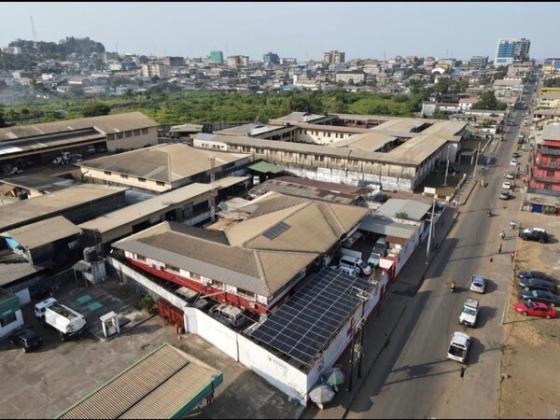Liberia: Red Cross Dedicates Solarized Headquarters in Monrovia

--- “Our solarized building will enable us to do this more efficiently, and we look forward to working with our partners and stakeholders in order to build a better future for all,” the President of the Red Cross, Jerome Clarke, said at the dedication ceremony recently.
The headquarters of the Liberia National Red Cross Society is now fully-powered by solar energy.
The milestone Solarized office project is implemented with funding from the Swedish Embassy near Monrovia. The 45kw solar power project, constructed at a cost of a little over US$100k was installed by the Elise Renewable Power Liberia.
The solar panels, on the roof of the building, generate electricity, stored in lithium-ion batteries and supplied throughout the LNRCS’ building to keep it functioning. The Red Cross has been serving communities in need for more than five decades, providing impartial humanitarian services to those who require support.
The organization's headquarters, acquired since June 1971, has been a key hub for coordinating and delivering these services. However, the high cost of electricity generated by fuel has presented a significant challenge for the organization, hampering its ability to provide aid to those who require it most.
But the solar energy initiative supported by the Embassy of Sweden through the Swedish Red Cross, will help to address this challenge—helping to reduce its reliance on expensive oil fuel for electricity generation.
This move has not only reduced costs for the organization, but it has also helped to mitigate the impact of its operations on the environment by reducing carbon emissions and air pollution, the president of the Red Cross, Jerome Clarke, said at the dedication ceremony recently.
“The significance of this move cannot be overstated. The Liberian Red Cross plays a vital role in providing essential support to vulnerable communities in Liberia, particularly in times of crisis,” he added.
With the increased frequency and intensity of natural disasters and other humanitarian emergencies, Clarke noted that LNRCS' ability to provide assistance quickly and efficiently is more important than ever before. “By reducing its reliance on expensive and polluting sources of energy, the organization can now focus more of its resources on providing life-saving support to those who need it most,” he said.
The Red Cross president disclosed that the solar energy project was a tough but the right decision, as it aligns with LNRCS’ commitment to sustainability and reducing carbon footprint.
He lauded the government for its support, noting that the initiative will add an advantage in response to the increased complexities of humanitarian needs in Liberia. He also reaffirmed the entity’s commitment to providing continued and impartial humanitarian services to people and communities in need.
“Our solarized building will enable us to do this more efficiently, and we look forward to working with our partners and stakeholders in order to build a better future for all,” Clarke stated.
The dedicatory ceremony of the project was performed by the Country Representative of the Swedish Red Cross Natxo Garcia Collantes.
He expressed his entity commitments to working with the LNRCS, to enhance humanity’s impact on Climate Change.
Collantes stressed that the Swedish Red Cross through the Sweden Embassy in Monrovia was delighted to collaborate with the LNRCS, which he described as a clear indication towards the Solarization of the building which will improve capabilities toward humanities.
He disclosed that the project was a part of an agreement that Sweden signed to support the “Green, Inclusive and Resilient Liberia Communities” (GIRL) program.
The GIRL program is implemented by the LNRCS with capacity support from the Swedish Red Cross.
It aimed at reducing disaster risks and increasing community resilience to climate change.
Collantes, however, hopes that the program will increase communities’ ability to adapt their lives to a changing climate and environment.
However, the solar energy initiative also sets an important example for other organizations and communities in Liberia and beyond. “As the world continues to grapple with the devastating impacts of climate change, finding ways to reduce our collective carbon footprint is essential,” the Secretary General of the Liberian Red Cross Gregory T. Blamoh spoke ahead of the dedication that would take place on Friday, March 10, 2023.
Mr. Blamoh added: “The decision to solarize our headquarters demonstrates that even small steps can make a big difference”. By taking action to reduce its energy consumption and carbon emissions, the Liberian Red Cross is contributing to a cleaner, more sustainable future for all.
Moving beyond today, the Liberian Red Cross's decision to solarize its headquarters represents a significant step forward for the organization and for the communities it serves. By reducing its reliance on expensive and polluting sources of energy, the organization can now focus more of its resources on providing essential humanitarian services to those who require support.
“Additionally, this initiative sets an important example for others to follow, demonstrating that even small steps towards sustainability can make a significant impact in mitigating climate change and protecting our planet for future generations”, he concluded.
Adolphus K. Karyah, Engineer of the Elise Renewable Power, told journalists that the total of 45kw System and standby of 54 pieces of high-arms batteries, estimated minimum life span is about four to five depending on its usages.
Karyah, disclosed that the utility generator can be used to supply electricity to the building only when it is unable to generate enough power on its own, for example during a prolonged spell of bad weather.
